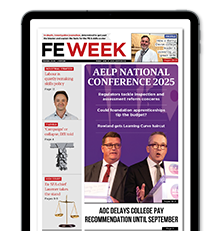Apprenticeships may not be a magic bullet, but neither are they the poisoned chalice the Royal College of Nursing would have us believe, argues Lucy Hunte
I recognise there are challenges with the implementation and roll-out of the nursing degree apprenticeship, but they are not for the reasons the Royal College of Nursing stated in their article in last week’s FE Week (“Nursing apprenticeships won’t work how the government wants”). Here are some of the claims made, and why I believe they are wrong.
Myth – The nursing apprenticeship is a poor-quality programme that risks reducing the quality of care.
Fact – The nursing degree apprenticeship is subject to exactly the same regulations as the traditional programme and can only be delivered by Nursing and Midwifery Council-approved higher education institutions. The only difference is that it is now funded by the levy.
Myth – Degree-based training is safer.
Fact – The Nursing Apprenticeship is a degree programme.
Myth – The apprenticeship levy does not cover the full cost of training.
Fact – The levy does cover the full cost of the degree, but not the backfill payments for the release time for when the apprentice nurse is away from the trust on placement or in learning.
Myth – Apprentice nurses will not have the same practice hours or placements.
Fact – They are subject to exactly the same NMC requirements as the traditional route, which includes supernumerary time.
Myth – The nurse apprenticeship is reducing access for mature students or those from diverse backgrounds.
Fact – The majority of the first wave of apprentice nurses are mature students from very diverse backgrounds. The apprenticeship could in fact widen participation as the apprentices will be employed and earning a salary. Many are existing healthcare assistants who, following the removal of the bursary, could not afford to give up work to study.
Myth – Apprenticeships are not the solution, with only 20 starts this year.
Fact – Approximately 400 nationally are due to start this year, with more to come in 2019. The removal of the bursary remains a concern and the apprenticeship is not the sole solution, but it is an alternative route to registration.
Backfill (the cost to cover staff when they are attending training) is an issue when many trusts are already under financial constraints, but this is only the case if you look at the nursing apprenticeship in isolation. If you look at it as part of a trust-wide workforce and apprenticeship strategy, then it becomes more viable. For example, trusts in North Central London have agreed an apprentice pay policy whereby all band 1 – 4 roles should be considered as apprenticeship opportunities, with new recruits receiving 70 per cent of the pay band for that role. This still puts the salary at well above the national apprentice wage, but the savings made can therefore go into a pot to help cover backfill.
We know the 20 per cent off-the-job element is sometimes difficult, but in reality the time required for off-the-job training is closer to 60 per cent for apprentice nurses and this is the real challenge – not the quality of the programme or the apprentices.
There have also been considerable delays due to procurement and HEI readiness, but we are seeing movement now and the appetite from employers is increasing. The National Apprenticeship Service has said that the nursing apprenticeship has been one of the most enquired-about programmes since its launch.
If you still have doubts, I would recommend talking to apprentice nurses!
If you still have doubts, then I would recommend talking to the apprentice nurses! I have had the pleasure of hearing a number of them speak at events over the past few months and quite often there is not a dry eye in the house. They are delighted at being given this opportunity to fulfil their dreams without having to take out student loans. Nurses are nurses, whatever training route they take, and the sooner the apprenticeship is given the parity of esteem it deserves, the better for all involved.
Some may argue that as the apprentices are employed and part of the workforce – unlike a university student who simply comes in for a placement – they could even be better, as an apprentice gets far more hands-on clinical and patient experience. The apprentice (unlike a traditional student) also does not have to undertake part-time non-related work just to pay
their bills.









Converting students into Apprentices to enable them to get paid and use the Levy pot may have advantages. However, this on its own will do nothing to address the industry need for a radically different approach to addressing the “nursing crisis” we all see. The Apprentice route should be an opportunity to do things differently not just fund things differently! The nursing crisis it would appear needs new thinking and approaches as to how we train and develop our future nurses for both the NHS and the private social care sector such as nursing homes and domiciliary care. Universities should be making contributions to the development of new approaches not focussed on protecting the self-serving status quo.
This was interesting reading, our biggest interest to date regarding apprentices was from staff wishing to undertake the Nursing Degree Apprenticeship. We have staff already on this programme